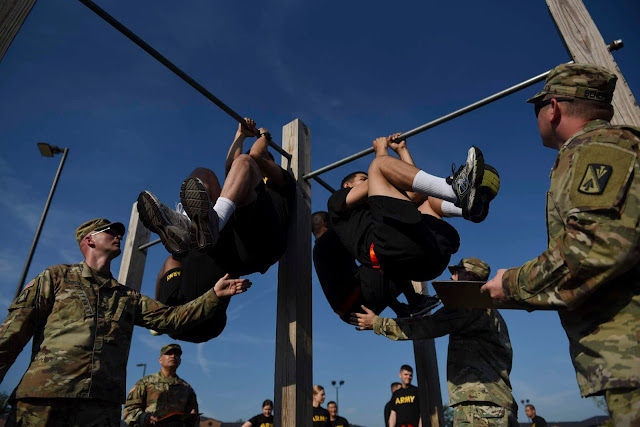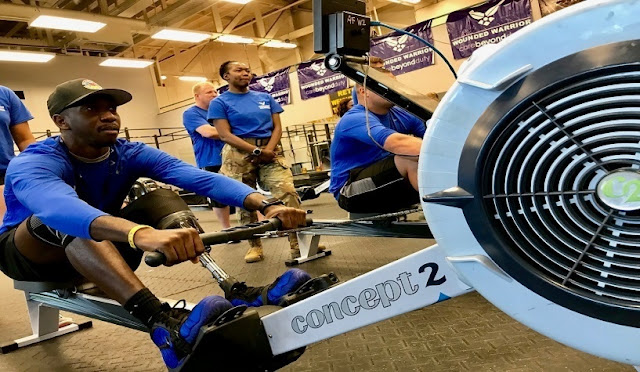Army public health experts offer expert advice for reducing MSK injuries
Army Public Health Center
Story by Douglas Holl
ABERDEEN PROVING GROUND, Md. – One of the challenges facing Army leadership as they transition to the new Army Combat Fitness Test, which will be fully implemented by October 2020, is preventing musculoskeletal training injuries. Physical training is necessary to develop and maintain the fitness required to accomplish military missions, but is also known to cause injury. According to Army Public Health Center experts, MSK injuries and related conditions led to an average of 37 limited duty days per injury. This translates to 2 million medical encounters across the Army annually and an estimated 10 million lost training days due to limited duty. “Seventy percent of all limited duty profiles are for MSK injuries,” said Dr. Michelle Chervak, acting manager for the APHC Injury Prevention Program, which identifies causes and risk factors for Army training-related injuries. “We can show that greater amounts of training (for example, of running or road marching) result in more injuries. Civilian data show us that there are levels of training above which injury rates increase, but fitness does not improve – two signs of overtraining.” Dr. Bruce Jones, senior scientist, APHC Clinical Public Health and Epidemiology Directorate, explained further that part of the problem for the Army is that the thresholds of training above which injury rates increase and fitness does not have not been established. However, commanders have the information necessary to make decisions about the thresholds – they know the amount of training, physical fitness of their Soldiers, and the number of Soldiers on profile. “What we need to provide commanders are the general principles of training injury prevention; and an understanding of the relationships between training, fitness, and injuries,” said Jones. “They have to determine the risk of injury they are willing to accept.” APHC Injury Prevention is working on updating financial and readiness costs to the Army due to MSK injuries. “At this time, the only formal cost estimate that we have comes from a National Safety Council report for the Secretary of Defense,” said Chervak. “That report stated the annual costs ranged from $12-20 billion (2001 data). Roughly 40 percent of all injuries across the Department of Defense occur to Army personnel, so the Army costs are approximately $4.8-8 billion.” The 2018 Health of the Force report highlights a previous Army success in reducing injury by changing its approach to fitness training. In 2003, the Army evaluated a new standardized physical training program designed to enhance fitness while minimizing injuries through avoidance of overtraining. An evaluation group implemented the new standardized program and a comparison group conducted traditional PT (running, calisthenics, push-ups, and sit-ups). After nine weeks of basic combat training, the evaluation group had fewer injuries and a higher APFT pass rate. The modified program reduced the total miles run by trainees, conducted distance runs by ability groups, added speed drills, executed warm-up exercises instead of pre-exercise stretching, progressed training amount and intensity gradually, and provided a wider variety of exercises. In 2004, the new standardized PT program based on this evaluated program was mandated for all BCT units across the Army. It was also incorporated into Army physical training doctrine. From 2003 to 2013, a 46 percent decrease in all injuries and a 54 percent decrease in lower extremity overuse injuries among Army trainees was observed. Jones recommends a five-step public health approach as the most effective construct for Army public health to organize and build an injury prevention program. Steps include surveillance to define the magnitude of the problem, research and field investigations to identify causes and risk factors, intervention trials and systematic reviews to determine what works to address leading risk factors, program and policy implementation to execute prevention, and program evaluation to assess effectiveness. Jones also notes that both overweight and underweight Soldiers who are the least physically fit are at the highest risk for injury compared to their most fit peers. “The highest risks occur among the most underweight (leanest), least physically fit (slowest run times) men and women in basic training,” said Jones. “This is probably because underweight Soldiers lack the muscle mass necessary to perform Soldiers tasks and withstand the vigorous physical activity required.” Injury risks are also 20 to 50 percent higher for Soldiers who smoke cigarettes. “A variety of hypotheses explain this relationship; the most feasible is that smokers have a reduced ability to heal following injury,” said Chervak. “Overuse injuries result from an inability to repair damage due to daily training; smokers repair that cumulative microtrauma less rapidly.” APHC is currently piloting a program through the Army Wellness Center at Fort Campbell focused on identifying Soldiers at highest injury risk based on APFT run time, the leading predictor of active-duty Army injury risk. APHC is working with specific units and the Fort Campbell Community Ready and Resilient Council to identify Soldiers who meet the criteria for referral (men: run time slower than 15 minutes; women: run time slower than 19 minutes), said Chervak. These Soldiers are offered AWC fitness assessments to assist with improving aerobic fitness, physical activity, sleep, and body composition. “AWC education efforts focus on physical activity, sleep, nutrition (weight loss), and tobacco cessation; all factors that influence injury risk,” said Chervak. “There is a natural partnership with APHC’s Health Promotion and Wellness directorate. Key avenues of influence are Performance Triad-related communications and referral of high risk Soldiers to the AWCs.” Jones said the most important step forward is for leadership to recognize that training-related injuries are a problem and they can be prevented. “Commanders need to recognize that there are no magic bullets,” said Jones. “Training causes injuries and modifications of training will prevent injuries. Commanders have the information to monitor injuries and fitness, and modify training to prevent injuries. We still need to determine the thresholds of training by unit at which injuries increase, but fitness does not improve.”




Comments
Post a Comment